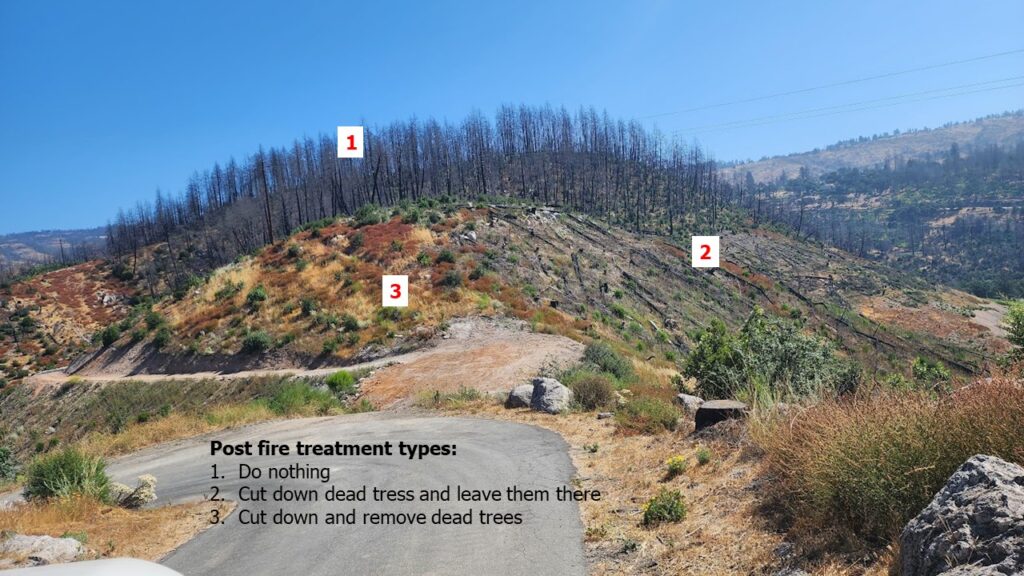Last month I took a long overdue holiday to drive from California to Canandaigua (my beautiful hometown in Western NY). We drove 3300 miles in a too-big U-Haul (due to a breakdown of the smaller one within 24 hours that we’d rented) across 14 states. Combining a bit of work – though it was hard to call it that as I was merely taking advantage of the drive to stop in and learn (a lot!) more about various biochar companies and initiatives. So I turned my time-off into what I’ll call a vocation-vacation (VV).
If I’d been on my own, I could have met up with many others, but I feel fortunate to have been able to connect with folks from The Clean Burn Company, the Sierra Fund, Go Biochar, Silver Lake Energy and Arti. Installment I from my cross country VV includes the origin story of a biochar company called The Clean Burn Company based in Calistoga, CA.
Not all firefighters carry a big hose. “Hand crew” firefighters carry chainsaws, pickaxes, shovels and more. They focus on fuel removal, remote rescue and ‘putting in lines’ which largely means cutting down trees to try to stop a fires’ forward movement. The work is hard and horrifically hot even on days when they are not breathing in smoke and ash. I’m told those that do this type of heroic work love it passionately. My nephew Anders is one of them. The ugly little secret is that the pay is decidedly lackluster, and the work is seasonal so the crews are on their own financially for several months per year.
To train for this work Anders tirelessly felled trees and cleared brush around his Dad’s beautiful home and vineyard for months. All of his work paid off not only in him securing him his dream job, but it ended up saving their home in 2017 during the Tubbs Fire and once again a few years later. It also led his father to start up a new company which provides new career opportunities for hand crew firefighters in the off-season.

The Clean Burn Company provides risk reduction services to those living in high fire risk areas. Increasingly I’m told that more and more customers are enquiring about turning their dangerously close combustibles into biochar instead of fully combusting it into ash. Music to my ears!
We visited one of their current projects which was helping a vineyard owner that had suffered from significant fire damage. Driving through fire ravaged landscapes years after the catastrophe is unsettling to say the least. You cannot help but grieve for all the losses, not just human but all the flora and fauna that perished. Unless these charred terrains are proactively revitalized, it can take decades for it to return to anything close to its previous splendor.
The vast majority of the burned landscapes are left untreated due to costs and limited accessibility (see #1 in picture). In some areas dead trees were felled and left on the land (#2). This looks marginally better than leaving them standing and apparently helps jump-start decomposition. In other cases, trees are felled, chipped and left on the land (not shown). These thick layers of mulch, which is normally used to suppress weeds, leads to not a very pretty picture or vibrant ecosystem.
In contrast to the current management practices, The Clean Burn Company provides a post-fire clean up service that fells dead trees and turns them into biochar (increasingly but not always!) using two different mobile kilns made by Air Burners; the Burn Boss and the Track Boss. They also selectively prune the prodigious volume of sprouts that compete for dominance for water and nutrients to enable faster regrowth (see #3 in picture).
While some in the biochar industry bemoan any biochar production whereby the excess heat is not utilized, this type of forestry thinning is increasingly necessary to reduce catastrophic wildfires. The Clean Burn Company, in close collaboration with those that know the most about fire, has figured out how to provide one of the few cost-effective options home-owners have to provide some level of protection as well as post-fire clean-up & eco-system recovery. Sometimes fighting fire with fire is the best strategy!
The US Forest Service has been working with Air Burners to optimize the amount of biochar which can be produced and will be coming out with a Char Boss sometime soon, rumor has it. Emissions testing and full life cycle assessments are in the works to potentially allow for carbon removal credits.
